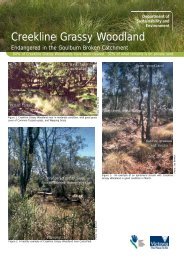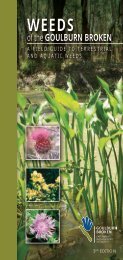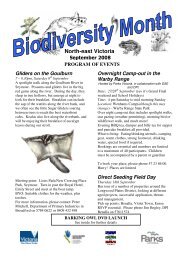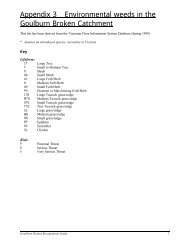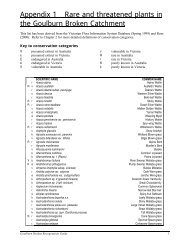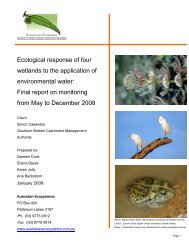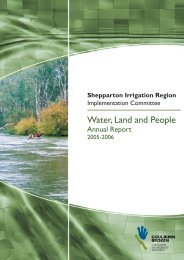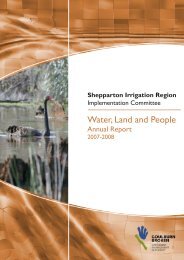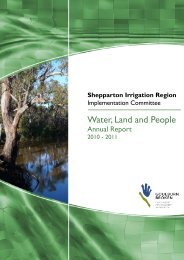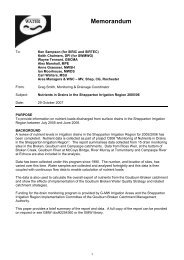Water, Land and People - Goulburn Broken Catchment ...
Water, Land and People - Goulburn Broken Catchment ...
Water, Land and People - Goulburn Broken Catchment ...
You also want an ePaper? Increase the reach of your titles
YUMPU automatically turns print PDFs into web optimized ePapers that Google loves.
• The broad implications of the scenarios are<br />
designed to enable users to readily identify<br />
strategies to maintain <strong>and</strong> increase the<br />
attractiveness of the region <strong>and</strong> consider how<br />
to build those strategies into their business<br />
or organisation.<br />
• The implications of the scenarios for specific<br />
issues are tailored recommendations for<br />
individual organisations in the region.<br />
One example of the project findings <strong>and</strong> how they<br />
are being adopted is:<br />
• The region has an extensive network of<br />
irrigation water supply infrastructure that<br />
has the ability to deliver water to the<br />
vast majority of properties in the region.<br />
However, much of this infrastructure<br />
is degrading <strong>and</strong> nearing the end of its<br />
design life. The scenarios highlight that<br />
water availability for irrigation may change<br />
significantly in the future due to variability<br />
<strong>and</strong> change in climate as well as potential<br />
changes in water policy. <strong>Water</strong> trade may<br />
also affect the amount of water used in the<br />
region <strong>and</strong> its spatial distribution. Therefore,<br />
there is great uncertainty in the size <strong>and</strong><br />
location of the irrigated area <strong>and</strong> amount of<br />
water used in the future. There may even be<br />
periods of rapid contraction <strong>and</strong> expansion<br />
of irrigation. Thus there is a need to build<br />
flexibility into irrigation infrastructure, so that<br />
it is adaptable to future dem<strong>and</strong>s. Flexibility<br />
may be achieved through innovative system<br />
configurations, distribution technologies,<br />
a mix of infrastructure ownership, <strong>and</strong><br />
improved management systems.<br />
To assist G-MW to implement this<br />
learning, the project team has initiated a<br />
further investigation aimed at providing<br />
a H<strong>and</strong>book of Flexible Technologies for<br />
Irrigation Infrastructure. This will provide<br />
a conceptual framework for the provision<br />
of flexibility in irrigation infrastructure, <strong>and</strong><br />
identifies the range of technologies available<br />
for the provision of flexibility in irrigation<br />
infrastructure.<br />
Where To From Here<br />
A key output from the project is the report<br />
“Scenarios of the future: Irrigation in the <strong>Goulburn</strong><br />
<strong>Broken</strong> region”. It provides the principal regionallevel<br />
output from the <strong>Goulburn</strong> <strong>Broken</strong> Irrigation<br />
Futures project.<br />
This includes background information on the<br />
catchment, the four Scenarios, their broad<br />
implications for the region, <strong>and</strong> strategies for the<br />
region to protect <strong>and</strong> strengthen the features<br />
that make it attractive for investment <strong>and</strong> living.<br />
It is intended to be a living document which is<br />
continually used <strong>and</strong> updated by agencies, industry<br />
associations <strong>and</strong> enterprises within the region.<br />
Policy Instrument Choice Framework<br />
A Policy Instrument Choice Framework has been<br />
developed to help policy practitioners from natural<br />
resource organisations such as State government<br />
<strong>and</strong> CMAs to select a package of policy instruments<br />
that achieve outcomes effectively <strong>and</strong> efficiently.<br />
To develop this framework we reviewed a number<br />
of existing frameworks <strong>and</strong> funding guidelines<br />
that policy practitioners have used when selecting<br />
instruments. We found that these frameworks<br />
placed an emphasis on efficiency at the expense<br />
of flexibility. As a consequence, we concluded<br />
that the existing frameworks were of limited<br />
value when policy practitioners were faced with<br />
a high level of uncertainty about the responses<br />
of l<strong>and</strong>holders <strong>and</strong> institutions to new policy<br />
instruments. Consequently we perceived there was<br />
a need to develop a new framework - the Policy<br />
Instrument Choice Framework (PCF) - for choosing<br />
policy instruments that enabled both efficiency <strong>and</strong><br />
flexibility to be considered.<br />
The PCF has been trialled on case studies from the<br />
<strong>Water</strong> $mart Farms Program as implemented in the<br />
SIR to evaluate the usefulness of the framework.<br />
The trial to date has shown that the PCF is valuable<br />
in:<br />
• Helping policy practitioners to systematically<br />
rationalise the selection of policy<br />
instruments by identifying <strong>and</strong> explaining<br />
PROGRAM REPORTS<br />
35



